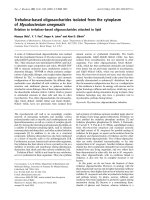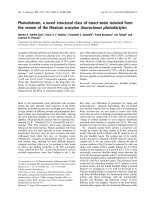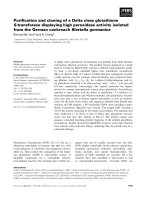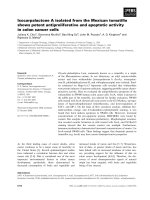Derivatives of triterpene isolated from the dichloromethane extract of helicteres hirsuta lour
Bạn đang xem bản rút gọn của tài liệu. Xem và tải ngay bản đầy đủ của tài liệu tại đây (271.19 KB, 8 trang )
AGU International Journal of Sciences – 2019, Vol. 7 (4), 12 – 19
DERIVATIVES OF TRITERPENE ISOLATED FROM THE DICHLOROMETHANE
EXTRACT OF HELICTERES HIRSUTA LOUR
Nguyen Van Ky1, Nguyen Huu Duyen1, Le Thanh Phuoc1
1
College of Natural Sciences, Can Tho University, Vietnam
Information:
Received: 07/08/2018
Accepted: 03/01/2019
Published: 11/2019
Keywords:
Betulin, betulinic acid,
lupeolactone, Helicteres
hirsuta Lour
ABSTRACT
Three natural compounds including betulin (1), betulinic acid (2) and
lupeolactone (3) were isolated from the dichloromethane extract of
Helicteres hirsuta Lour. for the first time. Their structures have been
elucidated by modern spectroscopic methods as IR, 1H-NMR, 13C-NMR,
DEPT, HSQC, HMBC, MS and by comparison with those of previously
reported data.
1. INTRODUCTION
Lour. was resistant to some experimental
cancer cells (Chin YW et al., 2006).
Helicteres hirsuta Lour. was introduced in the
previous paper of the research group (Duyen,
N.H. and Phuoc, L.T., 2016; Ky, N.V., et al.,
2018). Regarding the bioactivities, the results of
cytotoxic activity on Hep-G2 cell line of four
extracts
including
petroleum
ether,
dichloromethane, ethyl acetate and methanol,
showed that two extracts of petroleum ether and
dichloromethane gave positive test results with
the IC50 values being 28.29 µg/mL and 30.30
µg/mL, respectively. Regarding the chemical
constituents, the research team isolated six
compounds including stigmasterol; lupeol;
apigenin; tiliroside; α-p-hydroxy truxillic acid;
7,4’-di-O-methyl-8-O-sulphate isoscutellarein.
With the above-mentioned biological activities,
Helicteres hirsuta Lour. is potentially useful in
cancer treatment. Therefore, in this paper, the
research team continues to publish results of a
chemical composition survey to contribute to a
more
scientific
explanation
of
the
pharmaceutical application of this herb.
2. MATERIALS AND METHODS
Material: The specimens were stems, leaves
and flowers of Helicteres hirsuta Lour.
collected in Hon Son, Lai Son commune, Kien
Hai district, Kien Giang province and identified
by Mr. Dang Minh Quan, Director of
Department of Education, Can Tho Universit.
They were then washed, chopped, dried in
shade, and ground to fine powder as raw
materials used in the study.
In 2006, another research group announced the
isolation of six compounds: (±)-pinoresinol,
(±)-medioresinol,
(±)-syringaresinol,
(-)boehmenan, (-)-boehmenan H and (±)-transdihydrodiconiferyl alcohol. It also stated that
the extract from the trunk of Helicteres hirsuta
Method for extraction: the dried powder was
exhaustively extracted with methanol, then
12
AGU International Journal of Sciences – 2019, Vol. 7 (4), 12 – 19
proceeded to liquid-liquid extraction with
solvents of increasing polarity, and obtains
petroleum ether extract (PE), dichloromethane
extract (DC), ethyl acetate extract (EA) and
methanol extract (ME).
Dried powder of the aerial parts of the
Helicteres hirsuta Lour. (12.5 kg) was put into
a cloth bag and exhaustively extracted with
methanol at room temperature. After 24 hours,
the crude extract was filtered with a filter paper
and evaporated the solvent (3-4 times) to obtain
ethanol extract (200 g). Then, this extract was
suspended in distilled water (approximately
1:1) and partitioned with petroleum ether (PE),
dichloromethane (DC), ethyl acetate (EA), and
methanol (Me), respectively. The partitioned
solutions were removed solvent to give four
extracts: PE (105.3 g), DC (20.85 g), EA (18.35
g) and Me (15.6 g).
Method for isolation: Column chromatography
was used to isolate compounds with silica gel
(stationary phase) and elution solvent (mobile
phase), and to monitor column chromatography
and purity of compounds by thin layer
chromatography (fractions with the similar
characteristic on TLC were combined).
Recrystallization was used for purifying the
compound; the elution process started with
petroleum ether (PE), followed by polarization
by adding ethyl acetate (EA) in an appropriate
ratio. Detection was achieved by spraying the
mixture of vanillin, methanol and 10% H2SO4,
followed by heating, iron chloride (III) salt
solution, UV light with 254 nm wavelength.
Silica gel (230-400 mesh, India, Germany) was
used for column chromatography, Thin-layer
chromatography was performed on pre-coated
TLC F254 60 G (Merck, Germany).
Isolation
The DC extract was repeatedly subjected to
silica gel column, eluted with petroleum solvent
(PE) and the mixture of petroleum and ethyl
acetate with increasing polarity to yield 12
fractions, DC1-12.
Two fractions DC5 (PE: EA 9:1) and DC6 (PE:
EA 9:1) were dissolved in pure solvent
respectively in ascending order from petroleum,
ethyl acetate to methanol; then recrystallized. A
white power was obtained in methanol from the
fraction DC5, then checked by TLC (the
mixture solvent of petroleum and ethyl acetate,
PE: EA 4:1) with the show-up of a dark purple
mark after spraying the mixture of vanillinmethanol-10% H2SO4 followed by heating (Rf =
0.37). This compound is denoted as PKD01 (1).
Similarly, a white powder was obtained in
methanol from the fraction DC6 with the Rf
value being 0.33 in the same elution solvent.
This compound is denoted as PKD03 (3).
Method for structural analysis: the structures
of the compounds were determined by the
spectroscopic methods: IR, 1H-NMR, 13CNMR, DEPT, HSQC, HMBC, MS and related
documents to identify the chemical structure of
the isolated substances. The 1H- and 13C-NMR
spectra were measured by Bruker 500 MHz
equipment and the chemical shifts were given
on a δ (ppm) scale with tetramethylsilane
(TMS) as an internal standard, ESI-MS was
recorded with a VG 7070 Mass spectrometer
operating at 70 eV. All spectra were recorded at
Institute of Chemistry, Vietnam Academy of
Science and Technology, Hanoi.
3.
The fraction DC8 (PE: EA 7: 1) was
chromatographed to silica gel column, eluted
with the mixture of petroleum and ethyl acetate
(PE: EA) being gradually increased in the
polarity to obtain 3 fractions DC8a (PE: EA
7:1), DC8b (PE: EA 5:1) and DC8c (EA
100%). The fraction DC8a was further purified
by column chromatography to afford 4
RESULT AND DISCUSSION
3.1 Extraction and isolation
Extraction
13
AGU International Journal of Sciences – 2019, Vol. 7 (4), 12 – 19
subfractions: DC8a1 (PE: EA 10: 1), DC8a2
(PE: EA 7:1), DC8a3 (PE: EA 5:1) and DC8a4
(EA 100%). In the subfraction DC8a2, a pure
needle-shaped crystalline compound was
formed; then it was checked by TLC with the
mixture of petroleum ether and ethyl acetate
(PE: EA 2:1), showing a dark purple mark after
spraying the mix of vanillin-methanol-10%
H2SO4 following by heating (Rf = 0.15). This
compound is denoted as PKD02 (2).
Table 1. The 1H-NMR, 13C-NMR data of compound 1, 2 and 3
COMPOUND 1
No.
δH1 ppm
(J in Hz)
COMPOUND 2
δC1
ppm
COMPOUND 3
δH2 ppm
δC2
ppm
(J in Hz)
δH3 ppm
(J in Hz)
δC3
ppm
1
38.2
38.8
40.0
2
26.6
27.9
27.0
3
2.97 (1H, t, 5)
4
5
76.8
3.16
(1H,
5.5, 11.0)
38.5
0.62 (1H, s)
54.8
dd,
78.9
3.15 (1H, dd, 4.3,
7.0)
38.7
0.67 (1H, d, 9.5)
55.4
79.7
57.9
0.73 (1H, d, 10.0)
56.9
6
17.9
18.3
19.5
7
33.8
34.5
35.7
8
40.4
40.7
42.0
9
49.8
50.5
52.1
10
36.6
37.2
38.4
11
20.3
20.7
22.1
12
24.8
25.5
27.0
13
36.7
38.3
39.6
14
42.2
42.2
43.6
15
27.1
30.6
31.8
16
29.3
32.2
33.7
17
47.3
56.2
50.6
18
48.1
46.9
48.8
19
2.38 (1H, m).
47.3
3.0 (1H, td, 4.5)
49.4
3.09 (1H, td, 4.0)
48.5
20
150.3
150.7
152.3
21
29.0
29.7
30.9
22
33.8
37.0
38.4
23
0.87 (3H, s)
28.1
0.97 (3H, s)
27.1
14
1.95 (3H, s)
24.0
AGU International Journal of Sciences – 2019, Vol. 7 (4), 12 – 19
COMPOUND 1
COMPOUND 3
δH2 ppm
(J in Hz)
δC1
ppm
(J in Hz)
δC2
ppm
24
0.66 (3H, s)
15.7
0.95 (3H, s)
15.3
25
0.77 (3H, s)
15.9
0.82 (3H, s)
15.9
0.88 (3H, s)
16.7
26
0.98 (3H, s)
14.5
0.75 (3H, s)
16.0
1.00 (3H, s)
16.8
27
0.93 (3H, s)
15.7
0.94 (3H, s)
14,6
1.02 (3H, s)
15.1
28
3.52 (1H,
10.5)
d,
179.2
0.77 (3H, s)
16.1
3.09 (1H,
10.0)
d,
4.66
2.5)
d,
109.4
4.72 (H, s)
110.0
No.
29
δH1 ppm
COMPOUND 2
(1H,
57.9
109.5
4.73 (1H, s)
4.60 (1H, s)
δH3 ppm
(J in Hz)
δC3
ppm
181.0
4.58 (H, d, 17.0).
4.53 (1H, dd,
1.0)
30
1.63 (3H, s)
18.7
1.69 (3H, s)
19.3
3.2 Structural identification
1.71 (3H, s)
19.6
methylene carbons and 6 methyl carbons which
were characterized for a lupeane-type
triterpene. In the HMBC, the correlative signals
between the protons of methyl group δH 1.63
(δC 18.7, C-30) and double-bonded methylene
group at δH 4.66 and 4.53 (δC 109.5, C-29) with
the double-bonded quaternary carbon at δC
150.3 (C-20) and tertiary carbon of the
cyclopentane ring of lupane frame δC 47.3 (C17) showed the presence of isopropyl group.
The characteristic carbon signals of the
oxymethine group at δC 76.8 (C-3) and
oxymethylene group at δC 57.9 (C-28) are also
consistent with their proton signals on the 1HNMR spectrum and the correlation between the
protons of methyl group δH 0.87 (δC 28.1, C23), 0.66 (δC 15.7, C-24) with the carbon of
oxymethine group at δC 76.8 (C-3) and the
tertiary carbon of the first cyclohexane ring of
lupane frame at δC 38.5 (C-4), the correlation
between the two protons of oxymethylene
group at δH 3.52, 3.09 (δC 57.9, C-28) with the
methylene carbon at δC 33.8 (C-22), 29.3 (C-
Compound 1
The ESI-MS spectrum indicated a molecular
ion peak at m/z 443.1 [M]+, corresponding to
the molecular formula C30H50O2 (M = 442.73
đvC).
The 1H-NMR spectrum (500 MHz, MeOD, δH
ppm) showed the signal of an oxymethin group
at δH 2.97 (1H, t, 5.0); two signals of doublebonded methylene group at δH 4.66 (1H, d, 2.5
Hz) and 4.53 (1H, dd, 1.0 Hz); two signals of
oxymethylene group at δH 3.52 (1H, d, 10.5 Hz)
and 3.09 (1H, d, 10.0 Hz); six signals of methyl
group in the range δH 0.66-1.63. There were
also some signals of other methine and
methylene groups.
The 13C-NMR spectrum (125 MHz, MeOD, δC
ppm) in combination with DEPT-90 and
DEPT-135 spectra presented the 30 signals of
carbon atoms in total. Among them, 6
quaternary carbons, 6 methine carbons, 12
15
AGU International Journal of Sciences – 2019, Vol. 7 (4), 12 – 19
same IC50 value of 40 μg/mL. Betulin also
exhibits anti-HIV activity with the IC50 value of
6.1 μg/mL (Deed K.S.El et al., 2003). In
addition, betulin has a protective effect on the
liver and reduces the toxicity of CdCl2 at low
concentration of 0.1 μg/mL. The mechanism
can be explained that betulin promotes the
synthesis of proteins, which protect cells from
the effects of CdCl2 (Nobuhiko Muira et al.,
1999).
16). At the same time, with two oxygenated
groups, it is allowed to indicate the presence of
-CH2-OH and >CH-OH groups in the molecule
of the compound.
From the analysis of the above data combined
with published data of betulin (Khanh, T.C., et
al., 2007), compound 1 was identified as
betulin (Figure 1).
Betulin shows that there is a cytotoxic activity
on two cell lines (HeLa and Hep-2) with the
Figure 1. Structure and HMBC correlations of betulin
Comparing data with Betulinic acid–IR (KBr,
νmax cm-1) 3484 (–OH), 1686 (C=O), 1362
(CH2=CH-CH3), 1156 (C–O) (E KovacBesovic et al., 2009), it can be concluded that
compound 2 has an oxymethine group and a
carboxylic functional group (–COOH).
Compound 2
Infrared spectrum (IR), (KBr, νmax cm-1), the
signal at 3432.04 cm-1 is the characteristic
oscillation of the OH bond, 1688.90 cm-1 (C=O
bond), 1642.64 cm-1 (C=C bond), 1378.35 cm-1
(CH3 group), 1235.85 cm-1 (C–O bond).
16
AGU International Journal of Sciences – 2019, Vol. 7 (4), 12 – 19
The 1H-NMR spectra (500 MHz, CDCl3 and
MeOD, δH ppm) of compound 2 also appeared
similar proton signals but less than compound 1
by one oxymethylene group.
From the analysis of the above data combined
with the published data of betulinic acid
(Enamul Haque Md et al., 2006), compound 2
was identified as betulinic acid (Figure 2).
The 13C-NMR spectrum (125 MHz, CDCl3 and
MeOD, δC ppm) combined with DEPT-90,
DEPT-135 spectrum of compound 2 also
showed the total signals of 30 carbon atoms
similar to compound 1, but one oxymethylene
group less and one carboxylic carbon more at
δC 179.2.
Betulinic acid is a substance commonly found
in plants that has antimicrobial, antiinflammatory, anti-malarial and anti-cancer
properties
(Perumal
Yogesswari
&
Dharmarajan Sriam, 2005).
Figure 2. Structure of betulinic acid
secondary carbon at δC 57.9 (C-4). The
presence of isopropenyl group is similar to
compound 1, base on the HMBC correlations
between the protons of methyl group at δH 1.71
(δC 19.6, C-30) and double-bonded methylene
group at δH 4.72 and 4.58 (δC 110.0, C-29) with
the double-bonded quaternary carbon at δC
152.3 (C-20) and tertiary carbon of
cyclopentane ring of lupane frame at δC 50.6
(C-17).
Compound 3
The
ESI-MS
spectrum
showed
a
pseudomolecular ion peak at m/z 439.2
[M+H]+, corresponding to the molecular
formula C30H46O2 (M = 438.3 đvC).
The 1H-NMR spectrum (500 MHz, MeOD, δH
ppm) of compound 3 also appeared proton
signals similar to compound 2. In particular, the
proton signal of methyl group at δH 1.95 is
different from compound 2.
From the analysis of the above data combined
with the data of compound 2 (betulinic acid),
compound 3 was identified as lupeolactone in
comparison with published data (Kikuchi
Hiroyuki et al., 1983) (Figure 3).
The 13C-NMR spectrum (125 MHz, MeOD, δC
ppm) combined with spectrum of DEPT-90,
DEPT-135 of compound 3 showed the signals
of a total of 30 carbon atoms similar to
compound 2. But compound 2 has the presence
of the lactone ring identified by the correlation
in HMBC spectrum between the proton of
methyl group at δH 1.95 (δC 24.0, C-23) with
the carbonyl carbon at δC 181.0 (C-24),
oxymethine carbon at δC 79.7 (C-3) and
Lupeolactone was found to lower cholesterol
levels in normal and hypercholesterolemic rats
by oral administration (Serina L. Robinson, et
al., 2018).
17
AGU International Journal of Sciences – 2019, Vol. 7 (4), 12 – 19
Figure 3. Structure and HMBC correlations of lupeolactone
4. CONCLUSION
Forsskaoliana.
Saudi
Pharmaceutical Journal, 11(4), 184-191.
From dichloromethane extract, three triterpene
derivatives were isolated and identified: betulin,
betulinic acid and lupeolactone. All of them
were the first compounds isolated from
Helicteres hirsuta Lour.. This study contributes
to a more scientific explanation of the
medicinal properties of this herb (in which
betulin exhibits cytotoxic activity on the HeLa
and Hep-2 cell lines, which protect the liver and
reduce the toxicity of CdCl2; betulinic acid has
antibacterial, anti-inflammatory, antimalarial
and anti-cancer activity, according to previous
studies) and increases the phytochemistry data
of Helicteres hirsuta Lour. to 15 compounds.
Duyen, N.H., & Phuoc, L.T., (2016). Study on
chemical constituents and cytotoxic activity
on Hep-G2 cell lines of Helicteres hirsuta
L.. Can Tho University Journal of Science,
Part A: Natural Science, Technology and
Environment, 47, 93-97.
E Kovac-Besovic, K Duric, Z Kaloðera & E
Sofic. (2009). Identification and isolation of
betulin, betulinic acid and lupeol from birch
bark. Planta Medica, 75(09), 126-133.
/>Enamul Haque Md, Hussain Uddin Shekhar,
Akim Uddin Mohamad, Hafizur Rahman,
Mydul Islam AKM & Sabir Hossain M.
(2006). Triterpenoids from the stem bark of
Avicennia officinalis Dhaka. Univ.J.
Pharm.Sci.,
5(1-2),
53-57.
/>
REFERENCES
Chin YW, Jones WP, Rachman I, Riswan S,
Kardono LB, Chai HB, Farnsworth NR,
Cordell GA, Swanson SM, Cassady JM &
Kinghorn
AD.
(2006).
Cytotoxic
lignans from the stems of Helicteres hirsuta
collected in Indonesia. Phytotherapy
Research,
20(1),
6265. />
Khanh, T.C., Hang, N.T.M., Huong, D.T.M. &
Hung, N.V., (2007). Study on the
chemical composition
of
roots
of
Pseuderanthenum palatiferum. Vietnamese
Journal of Science and Technology, 6 (DB),
309-314.
Deed K.S.El, Al-Haidari RA, Mossa J.S &
Abdel Monem A. (2003). Phytochemical
and Pharmacological studies of Maytenus
18
AGU International Journal of Sciences – 2019, Vol. 7 (4), 12 – 19
Kikuchi Hiroyuki, Tensho Akira, Shimizu
Iwao,
Shiokawa
Hideaki,
Kuno
Atsushi, Yamada
Seiichiro,…
Tomita
Kenichi. (1983). Lupeolactone, a new βlactone from Antidesma pentandrum Merr.
Chemistry Letters 1983 (4), 603606. />
triterpene
compounds
against
the
cytotoxicity of Cadmium in Hep-G2 Cells.
Molecular Pharmacology, 56, 1324-1328.
/>Perumal Yogesswari & Dharmarajan Sriam.
(2005). Betulinic acid and its derivatives: A
review on their biological properties.
Current Medicinal Chemistry, 12, 657666. />2214
Ky, N.V., Phuoc, L.T. & Duyen, N.H., (2018).
Sulphated and α-truxillic-acid derivatives
of flavonoids
isolated
from
the
dichloromethane extracts of Helicteres
hirsuta Lour. Vietnamese Pharmaceutical
Journal, Research-Technoques, 505 (58),
57-60.
Serina L. Robinson, James K. Christenson &
Lawrence P. Wackett, (2018). Biosynthesis
and chemical diversity of β-lactone natural
products. Natural Product Reports, View
Article
Online. />
Nobuhiko Muira, Yoko Matsumoto, Shinichi
Miyairi, Shoji Nishiyama & Akira
Naganuma. (1999). Protective effects of
19









